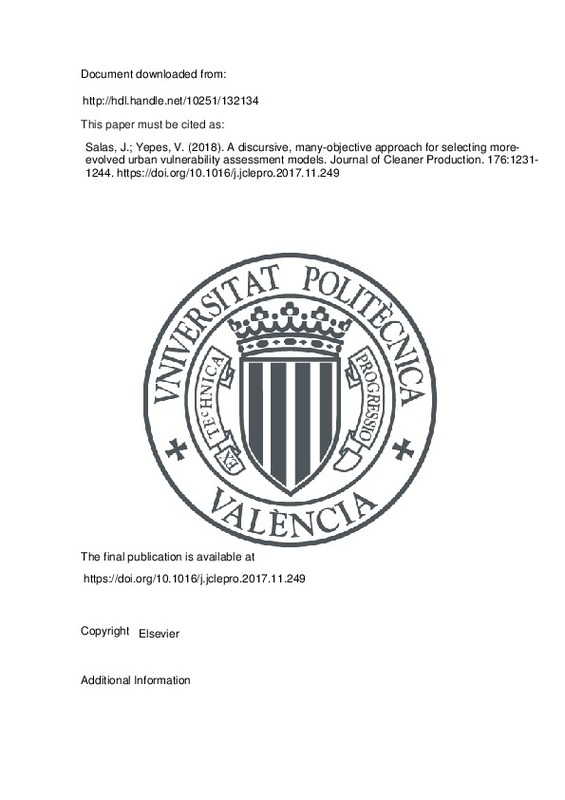JavaScript is disabled for your browser. Some features of this site may not work without it.
Buscar en RiuNet
Listar
Mi cuenta
Estadísticas
Ayuda RiuNet
Admin. UPV
A discursive, many-objective approach for selecting more-evolved urban vulnerability assessment models
Mostrar el registro sencillo del ítem
Ficheros en el ítem
| dc.contributor.author | Salas, Jorge
|
es_ES |
| dc.contributor.author | Yepes, V.
|
es_ES |
| dc.date.accessioned | 2019-11-30T21:01:34Z | |
| dc.date.available | 2019-11-30T21:01:34Z | |
| dc.date.issued | 2018 | es_ES |
| dc.identifier.issn | 0959-6526 | es_ES |
| dc.identifier.uri | http://hdl.handle.net/10251/132134 | |
| dc.description.abstract | [EN] The development of more-evolved urban vulnerability assessment (UVA) models has become an increasingly important issue for both policy agendas and academia. Several requirements have already been set for this goal; they should be pursued simultaneously. However, methods with such integration are yet to be developed. The present paper addresses this integration via a discursive process in which interactions between decision makers and the method contribute to the selection of a model fulfilling these requirements. That model yields a UVA built upon both qualitative information and quantitative data from indicators selected for the neighbourhood, city, province, region and country political-administrative scales. The characteristics demanded are encoded both into the UVA assessment model and in the optimization and control modules governing the process. While the optimization produces compromise solutions, the control module supervises the process, provides dynamic control and enables the interactions. Interactions are informed with knowledge derived from the cognitive approach entailed by the method and afford a better understanding of the process dynamics. We conclude that the goodness of fit and time dynamics objectives are aligned. Therefore, UVA methods performing well for these objectives are available, although at the expense of a medium to poor performance in preferences and robustness | es_ES |
| dc.language | Inglés | es_ES |
| dc.publisher | Elsevier | es_ES |
| dc.relation.ispartof | Journal of Cleaner Production | es_ES |
| dc.rights | Reserva de todos los derechos | es_ES |
| dc.subject | Urban vulnerability assessment | es_ES |
| dc.subject | Discursive approach | es_ES |
| dc.subject | Many-objective optimization | es_ES |
| dc.subject | Cognitive approach | es_ES |
| dc.subject.classification | INGENIERIA DE LA CONSTRUCCION | es_ES |
| dc.title | A discursive, many-objective approach for selecting more-evolved urban vulnerability assessment models | es_ES |
| dc.type | Artículo | es_ES |
| dc.identifier.doi | 10.1016/j.jclepro.2017.11.249 | es_ES |
| dc.rights.accessRights | Abierto | es_ES |
| dc.contributor.affiliation | Universitat Politècnica de València. Departamento de Ingeniería de la Construcción y de Proyectos de Ingeniería Civil - Departament d'Enginyeria de la Construcció i de Projectes d'Enginyeria Civil | es_ES |
| dc.description.bibliographicCitation | Salas, J.; Yepes, V. (2018). A discursive, many-objective approach for selecting more-evolved urban vulnerability assessment models. Journal of Cleaner Production. 176:1231-1244. https://doi.org/10.1016/j.jclepro.2017.11.249 | es_ES |
| dc.description.accrualMethod | S | es_ES |
| dc.relation.publisherversion | https://doi.org/10.1016/j.jclepro.2017.11.249 | es_ES |
| dc.description.upvformatpinicio | 1231 | es_ES |
| dc.description.upvformatpfin | 1244 | es_ES |
| dc.type.version | info:eu-repo/semantics/publishedVersion | es_ES |
| dc.description.volume | 176 | es_ES |
| dc.relation.pasarela | S\350100 | es_ES |







![[Cerrado]](/themes/UPV/images/candado.png)

